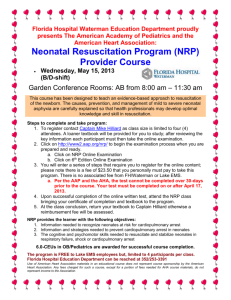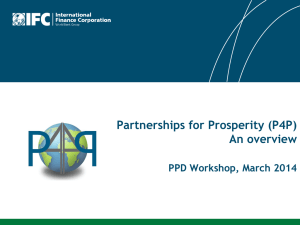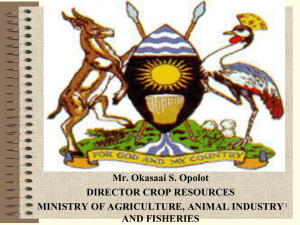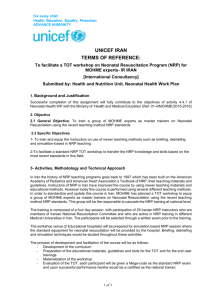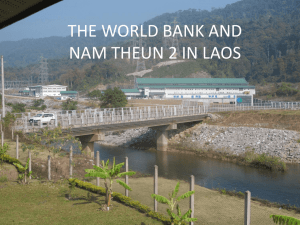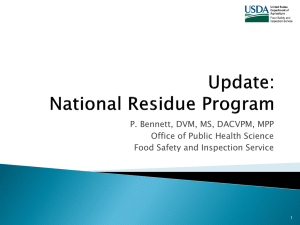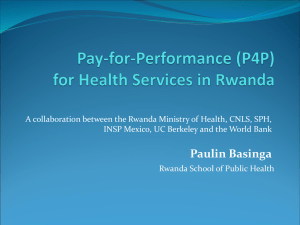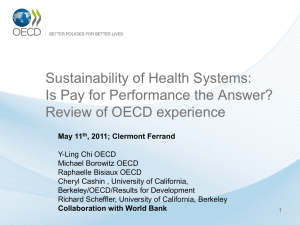Mutuku Judith - Department of Agricultural Economics
advertisement
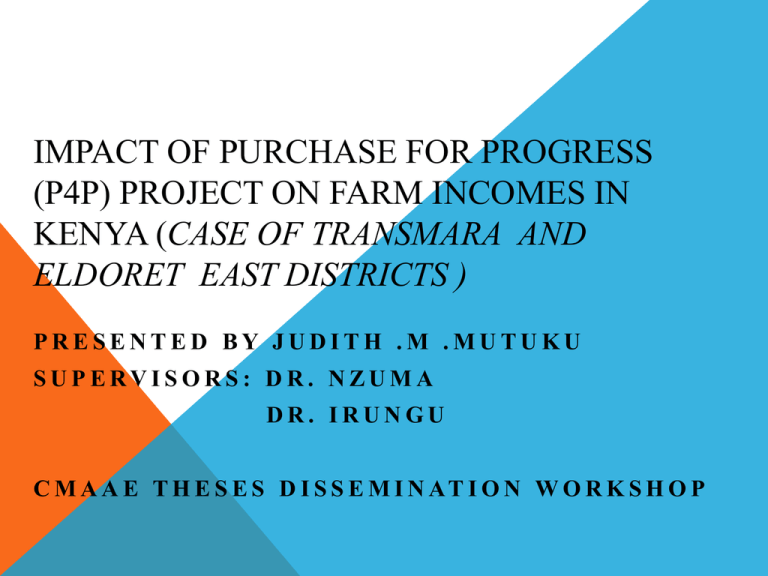
IMPACT OF PURCHASE FOR PROGRESS (P4P) PROJECT ON FARM INCOMES IN KENYA (CASE OF TRANSMARA AND ELDORET EAST DISTRICTS ) PRESENTED BY JUDITH .M .MUTUKU SUPERVISORS: DR. NZUMA DR. IRUNGU C M A A E T H E S E S D I S S E M I N AT I O N W O R K S H O P PRESENTATION OUTLINE Introduction Problem Statement Objectives Hypotheses Justification Methodology Results and Discussion Conclusion and Policy Implications INTRODUCTION WFP assists about 90 million people per year food in over 70 countries Purchase for progress (P4P) is a programme implemented by the WFP in 21 countries in parts of Africa, Central America and Asia. P4P is a 5 year pilot project implemented in Kenya in 2009 with an aim of moving smallholder farmer groups from informal into structured trade. In Kenya, targeted areas were Eastern, Rift valley and western provinces. INTRO…. The P4P project in Kenya works closely with the Ministry of Agriculture and partners such as CGA, AGMARK,AMPATH, KACE, farmers and agrodealers. The partners assist farmers in meeting WFP quality requirements and capacity building to participate in market. PROBLEM STATEMENT The P4P project has been in operation for three years since 2009 with reported achievements and challenges. However, the impact of P4P project on farmer’s income is largely unknown in Kenya thus the need for reliable empirical evaluations that provide evidence on its impacts It is also not known whether the P4P project has increased agricultural production, improved postharvest handling and marketing choices. PURPOSE AND OBJECTIVES Overall Objective: To quantify the impact of WFP’s P4P project on farm incomes among the smallholder farmers in Uasin Gishu and Narok counties in Kenya. Specific objectives: Assess the differences in maize gross margins between P4P participants and non-participants. Evaluate the impact of the P4P project on maize gross margins Hypotheses Tested There are no differences in the maize gross margins between P4P participants and non-participants Participating in P4P has no effect on maize gross margins METHODOLOGY Economic theory; Random Utility Model theory(RUM) First objective: Gross margin analysis Grossmargin TR TVC ( PQ TVC ) Where TR= revenue, TVC=variable cost, P=price of maize Q = quantity of maize produced. … Second objective: PSM First step; logit model; Participation Eqn: = 1 and 0 otherwise) = βo+ β1 AGE + β2 EDUC + β3 GENDER + β4 CREDIT + β5 HHSIZE + β6 FARMSIZE + β7 MZPRICE + β8 EXTN + β9 DISTANCE + β10 FOMEMBER + β11 OCCUPATION + e (error term) Second Step: PSM Matching Methods Y * (Grossmargin) a bRi cXi ei Where a is a constant, b measures impact of P4P on mean output, c is the average treatment effect, Ri - dummy variable = 1 if farmer i participates in P4P project and 0 otherwise, Xi are propensity scores from the preceding logit model and ei is the error term RESULTS AND DISCUSSION Attribute Uasin Gishu county Mean- P4P (N=57) Age (years) HHsize – persons Years of schooling Farm size (acres) Price of 90 kgbag of maize (KShs) Maize yield (90kg-bag / acre) Gross margin/ Farm income: Kshs/ha/year) Distance to the P4P store (Kms) Narok county Mean-NonP4P (N=69) 45 (1.58) 6 (0.32) 10 (0.457) 6 (1.44) 2946 (31.18) 47 (1.76) 6 (0.425) 9 (0.41) 5 (0.73) 2620 (34.02) 21 (0.31) 19 (0.49) 38994 (708.09) 16 (1.44) t-test Mean- P4P (N=57) Mean-NonP4P (N=69) t-test 44 (1.48) 8 (0.433) 7 38 (1.16) 7 (0.445) 9 14 (3.88) 3125 (37.20) 22 (3.88) 3086 (54.53) ** 20 (1.82) 15 (0.58) ** 31627 (990.22) *** 34877 (716.05) 27624 (676.53) *** 10 (1.05) ** 11 (2.11) 12 (1.40) *** ** ** *** RESULTS AND DISCUSSION First Objective- Gross margin analysis The difference in mean between the P4P participants and non participants was statistically significant at 1 percent –reject null hypothesis. Farm income (Ksh / acre/year) Mean Mean t- statistics difference P4P farmers 36 954 7313.55 *8.886 Non P4P 29 640 farmers DETERMINANTS OF PARTICIPATION Maximum likelihood Marginal effects estimates Variables Coefficient p-value Coefficient p-value Gender 0.005 0.179 0.023 **-0.990 Age 0.005 0.736 -0.002 0.667 Education -0.007 0.866 0.003 0.728 Occupation 0.274 0.385 -0.582 0.404 Hldsize 0.068 0.224 -0.004 0.772 Farm size Price market extension *-0.016 ***0.002 0.053 0.000 0.003 -0.000 0.066 0.000 0.021 0.133 -0.004 0.274 ***1.887 0.000 -0.377 0.000 DISTRIBUTION OF PROPENSITY SCORES AND AREA OF COMMON SUPPORT P-value of the logit model = 0.000 model fits the data well 0 .2 .4 Propensity Score Untreated .6 .8 Treated 1 IMPACT OF P4P PARTICIPATION ON FARMERS INCOME Matching Sample Treated Control Differen Std T stat ce error Unmatc hed 36953 29674 NNM ATT ATU ATE 36953 29674 29674 36291 KBM RM 7279 847 8.58 7245 1213.94 6616 6903.23 5.97** ATT ATU ATE 36953.94 29793.36 7160.57 1035.43 29674.53 36581.70 6907.16 7022.63 6.92** ATT ATU ATE 36953.94 29240.48 6974.14 1308.56 29694.53 36134.98 7037.95 7008.87 7.13** CONCLUSIONS P4P project has; Increased participants incomes by 7245ksh/acre/year (NNM) Increased participants productivity by 3-90 kg bags/acre Created a ready market for maize Improved participants access to credit especially through partnership with equity bank Improved participants access to extension through its partners like MoA, CGA etc Improved collective marketing through FOs POLICY IMPLICATIONS Need to encourage farmers to participate in P4P project for better prices and assured market The government and other institutions that lend credit should design better policies for credit packages that are tailor-made for farmers-fair collateral The government should enhance extension services through extension personnel to equip farmers with the appropriate knowledge to improve farm productivity. Policies which encourage farmers to market collectively should be enacted as well as timely payments to avoid delayed payments THANK YOU GOD BLESS
